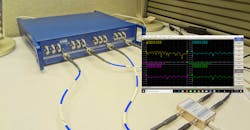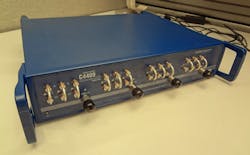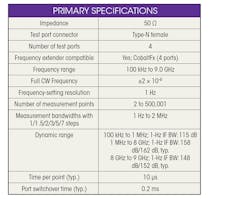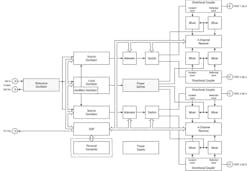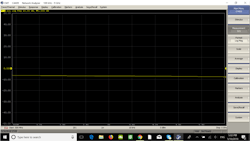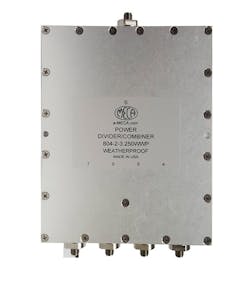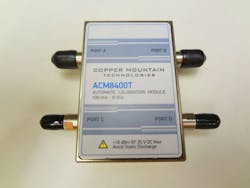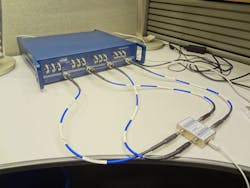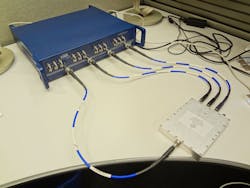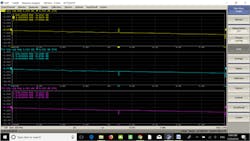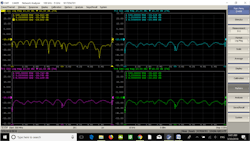Familiarize Yourself with the Latest in Vector Network Analysis
Download this article in PDF format.
Last fall, I wrote an article titled “Copper Mountain Technologies Takes 1-Port VNAs to the Next Level,” which focused on the company’s R180 1-port vector network analyzer (VNA). Introduced last year, the R180 covers a frequency range of 1 MHz to 18 GHz, and is well suited for measuring cables, antennas, and more.
I recently had the chance to spend some time with Copper Mountain Technologies’ C4409 4-port VNA, so we’ll continue that previous article’s theme here by taking a closer look at this instrument (Fig. 1). The C4409 is part of the Cobalt Series of VNAs, which operate in conjunction with a laptop or desktop computer. Specifically, a Cobalt VNA connects to a computer via a USB cable, and that computer is used to display all VNA measurements. This functionality differs in comparison with traditional benchtop VNAs, which have a built-in measurement display.
1. The C4409 4-port VNA is a member of Copper Mountain Technologies’ Cobalt series.
General Overview
The C4409 VNA covers a frequency range of 100 kHz to 9 GHz. Of particular note is the C4409, as well as three other Cobalt VNAs, can be used in conjunction with the CobaltFX millimeter-wave (mmWave) frequency extension systems. Using these frequency extenders together with a Cobalt VNA allows measurements to be performed at mmWave frequencies, thereby creating a measurement solution suitable for higher-frequency applications like 5G communications.
For purposes of this article, the C4409 VNA was used by itself. The table lists some of the main specifications of the C4409, such as measurement bandwidth and dynamic range. The C4409 is built with type-N female test port connectors. Output power from the test ports ranges from −60 to +15 dBm.
2. Here’s a block diagram of the C4409.
Since the C4409 is a four-port VNA, it’s not limited to just measuring two-port components. It’s also well-equipped to measure multi-port devices-under-test (DUTs), as it can provide users with 3- or 4-port S-parameter measurement data (i.e., S11…S44). Figure 2 shows a block diagram of the C4409.
Additional Capabilities
In addition to S-parameter measurements, several other measurements are made possible by using the C4409 (and the other Cobalt VNAs). For example, mixer/converter measurements can be performed using one of two different methods. The first is the scalar method based on the frequency offset mode, which allows users to measure reflections in vector form and transmissions in scalar form (magnitude only) of mixers/converters. An external mixer is not needed to perform the measurement, but a calibration requires an external power meter.
The second approach is the vector method. It allows for measurements of both reflections and transmissions in vector form, including phase and group delay of the transmission coefficient. Utilizing the vector method requires an external mixer, as well as a local oscillator (LO) that’s common to both the external mixer and the mixer-under-test. The C4409 and other 4-port VNAs allow one to use the unused port as the auxiliary source to supply the external LO signal to the mixer.
Among the other capabilities of the Cobalt VNAs are time-domain measurements, which enable users to determine the DUT response to various time-domain stimulus types. With time-domain analysis, users can detect physical impairments in cables. It also allows for surface-acoustic-wave (SAW) filter measurements, such as time delay and feedthrough signal suppression.
VNA Analysis Software
As mentioned earlier, the Cobalt VNAs differ from traditional benchtop VNAs, as the measurements are not displayed on the VNA itself. To operate a Cobalt VNA, one must connect it to an external computer with a USB cable. That computer then assumes the responsibility of displaying the VNA measurements.
Of course, the first task is to install the appropriate software. Copper Mountain Technologies currently offers a few different software programs free of charge on its website. In the previous article, the RVNA program was used, because it’s intended to be used with the company’s 1-port VNAs. Also available are the TRVNA and S2VNA programs for its 2-port VNAs (the TRVNA program with instruments capable of 2-port, 1-path measurements, while the S2VNA program is used with instruments capable of 2-port, 2-path measurements). Lastly, the S4VNA program is intended to be used with the 4-port VNAs, which is obviously the one used here.
3. This figure illustrates the interface of the S4VNA software.
Figure 3 illustrates the S4VNA program, revealing standard VNA functions that are likely already familiar to most VNA users. The user interface (UI) lets users select from various menu buttons, including Stimulus, Measurement, Format, Scale, Average, and Display. Additional menu buttons are Calibration, Markers, Analysis, Save/Recall, and System. These options can also be selected from the dropdown menu located at the top.
Selecting the Stimulus menu button subsequently allows users to enter start, stop, and center frequencies. The number of measurement points and the test port power levels can also be specified here. Furthermore, users are able to specify the IF bandwidth, which can be lowered to increase the VNA’s dynamic range.
Not all of the options associated with each menu button will be discussed in detail here, but they should be mostly familiar to those who have already used VNAs. The software has the benefit of being easy-to-use, so it should be relatively pain-free for new users to get acclimated. And to make it even easier, the Demo Mode feature (also mentioned in the previous article) essentially displays a simulated VNA measurement, thus allowing users to explore the software without even needing an actual unit to test. The Demo Mode feature can be turned on or off at any time.
The C4409 in Action
4. This power divider served as the DUT when using the C4409 VNA.
To demonstrate the C4409 VNA, we’ll do a simple measurement. Here, the C4409 VNA is used to measure a model 804-2-3.250WWP 4-way power divider from MECA Electronics (Fig. 4). This component operates from 500 MHz to 6 GHz.
5. Shown here is the automatic calibration module.
The VNA was calibrated over the full DUT operating frequency range of 500 MHz to 6 GHz. Automatic calibration was performed thanks to the ACM8400T automatic calibration module (Fig. 5). With this module, a 4-port VNA calibration can be performed with just a few mouse clicks. Figure 6 shows the C4409 VNA connected to the ACM8400T. Of course, following calibration, the VNA was connected to the power divider (Fig. 7). A 50-Ω termination was placed on the unused port of the power divider.
6. The VNA is connected to the automatic calibration module. Once connected, calibration can be carried out with just a few mouse clicks.
7. In this figure, the DUT (power divider) is connected to the VNA.
Figure 8 depicts the measured insertion loss of the power divider, showing data for S21, S31, and S41. In addition, the measured return loss at each of the power divider ports is represented by the S11, S22, S33, and S44 measurement plots (Fig. 9).
8. With the C4409, S21, S31, and S41 measurement data is displayed simultaneously.
9. These measurement results represent the return loss at each of the power divider ports.
While this example is simple, it helps demonstrate the capability of the C4409 to measure multi-port DUTs. In addition, the automatic calibration module greatly simplifies VNA calibration, saving a great deal of time and effort. Another point to mention is that S-parameter data can be saved as a touchstone file. The S4VNA program also has the ability to load touchstone files, allowing previously measured data to be analyzed.
Like the R180 1-port VNA featured in the previous article, the C4409 4-port VNA is an effective and easy-to-use solution for anyone in need of a VNA. Whether you are looking for a 1-, 2-, or 4-port VNA, Copper Mountain Technologies products are worthy of consideration. And with the CobaltFX millimeter-wave (mmWave) frequency extenders, the company can now offer measurement solutions at mmWave frequencies to enable testing for 5G applications and more.
